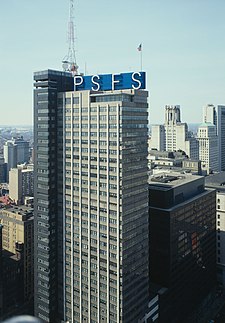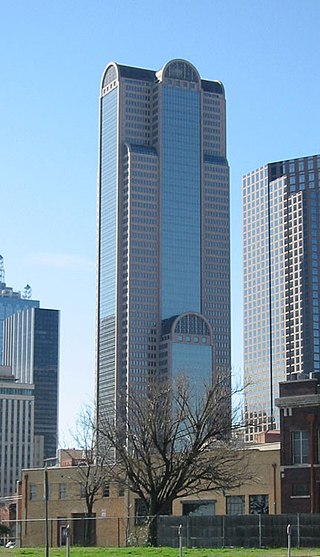
Comerica Bank Tower is a 60-story postmodern skyscraper located at 1717 Main Street in the Main Street District in downtown Dallas, Texas. Standing at a structural height of 787 feet (240 m), it is the third tallest skyscraper in the city of Dallas. It is also the sixth tallest building in Texas and the 61st tallest building in the United States. The building was designed by Philip Johnson and John Burgee, and was completed in 1987. The structure has 1,500,000 square feet (100,000 m2) of office space.
The Philadelphia Savings Fund Society (PSFS), originally called the Philadelphia Saving Fund Society, was a savings bank headquartered in Philadelphia, Pennsylvania, United States. PSFS was founded in December 1816, the first savings bank to organize and do business in the United States. The bank would develop as one of the largest savings banks in the United States and became a Philadelphia institution. Generations of Philadelphians first opened accounts as children and became lifelong depositors.

William Edmond Lescaze, was a Swiss-born American architect, city planner and industrial designer. He is ranked among the pioneers of modernism in American architecture.

28 Liberty Street, formerly known as One Chase Manhattan Plaza, is a 60-story International style skyscraper between Nassau, Liberty, William, and Pine Streets in the Financial District of Manhattan in New York City. The building, designed by Gordon Bunshaft of Skidmore, Owings & Merrill (SOM), opened in 1961. It is 813 feet (248 m) tall.

Comcast Center, also known as the Comcast Tower, is a skyscraper in Center City Philadelphia. The 58-story, 297-meter (974 ft) tower is the second-tallest building in Philadelphia and in the U.S. state of Pennsylvania, and the 31st-tallest building in the United States. Originally called One Pennsylvania Plaza when plans for the building were announced in 2001, the Comcast Center went through two redesigns before construction began in 2005. Comcast Center was designed by Robert A.M. Stern Architects for Liberty Property Trust.

The Cira Centre is a 29-story, 437-foot (133 m) office high-rise in the University City section of Philadelphia, directly connected to Amtrak's 30th Street Station. Developed by Brandywine Realty Trust and designed by César Pelli, it was built in 2004-05 on a platform over rail tracks.
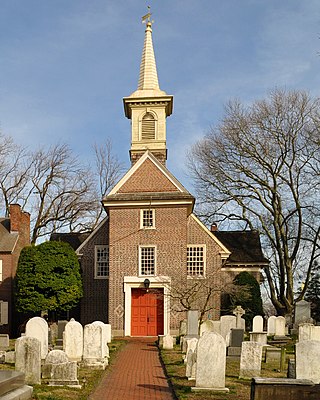
The architecture of Philadelphia is a mix of historic and modern styles that reflect the city's history. The first European settlements appeared within the present day borders of Philadelphia, Pennsylvania in the 17th century with most structures being built from logs. By the 18th century, brick structures had become common. Georgian and later Federal style buildings dominated much of the cityscape. In the first half of the 19th century, Greek revival appeared and flourished with architects such as William Strickland, John Haviland, and Thomas U. Walter. In the second half of the 19th century, Victorian architecture became popular with the city's most notable Victorian architect being Frank Furness.
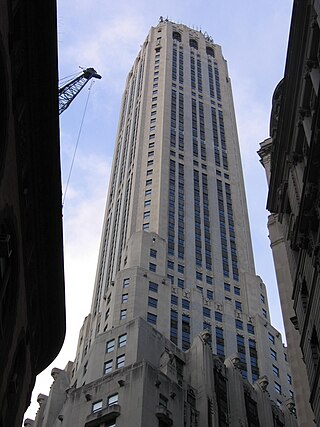
20 Exchange Place, formerly the City Bank–Farmers Trust Building, is a skyscraper in the Financial District of Lower Manhattan in New York City. Completed in 1931, it was designed by Cross & Cross in the Art Deco style as the headquarters of the City Bank–Farmers Trust Company, predecessor of Citigroup. The building, standing at approximately 741 feet (226 m) with 57 usable stories, was one of the city's tallest buildings and the world's tallest stone-clad building at the time of its completion. While 20 Exchange Place was intended to be the world's tallest building at the time of its construction, the Great Depression resulted in the current scaled-back plan.

Liberty Place is a skyscraper complex in Philadelphia. The complex is composed of a 61-story, 945-foot (288 m) skyscraper called One Liberty Place, a 58-story, 848-foot (258 m) skyscraper called Two Liberty Place, a two-story shopping mall called the Shops at Liberty Place, and the 14-story Westin Philadelphia Hotel.

Commerce Square is a Class-A, high-rise office building complex in Center City Pennsylvania. Commerce Square consists of One and Two Commerce Square, two identical 41-story office towers 565 feet (172 m) high that surround a paved courtyard of 30,000 square feet (2,800 m2).

The Wells Fargo Building, originally the Fidelity-Philadelphia Trust Company Building, is a skyscraper in Center City, Philadelphia, Pennsylvania, United States. Designed in the Beaux-Arts style by the architectural firm Simon & Simon, the building was erected for the Fidelity-Philadelphia Trust Co. in 1928. The 30-story high-rise is listed on the National Register of Historic Places.

The St. James is a luxury residential skyscraper in Washington Square West, Philadelphia, Pennsylvania, United States. The 498 feet (152 m), 45-story high-rise stands along Walnut Street and Washington Square and is the 15th tallest building in Philadelphia.
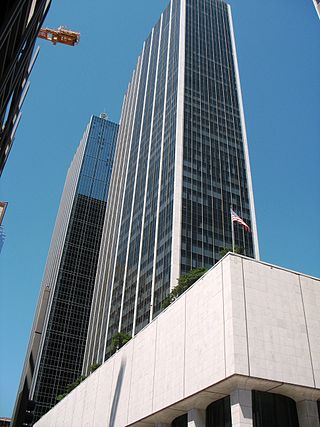
The National is a 52-story, 191 m (627 ft) skyscraper in the Main Street district of downtown Dallas, Texas, adjacent to the Dallas Area Rapid Transit (DART) Akard Station. It is the tenth tallest building in the city. In January 2010 the building was closed due to low occupancy rates. It was listed on the National Register of Historic Places in 2017.

Centre Square is an office complex in Center City Philadelphia, Pennsylvania. The complex consists of two concrete high-rise towers: the 417 feet (127 m) Centre Square I, also known as Centre Square East, and the 490 feet (150 m) Centre Square II represent the 24th and 15th-tallest buildings in Philadelphia, respectively. Designed by Vincent Kling & Associates in the 1960s, Centre Square opened in 1973. The complex is credited with shifting Philadelphia's downtown office district from South Broad Street to West Market Street. A tenant since 1975, management consulting firm Willis Towers Watson is Centre Square's largest tenant.

The Residences at The Ritz-Carlton is a luxury residential skyscraper in Center City in Philadelphia, Pennsylvania. At 518 feet (158 m), the 48-story skyscraper is the 12th-tallest building in Philadelphia, and the tallest residential tower in the city.

One South Broad, also known as the Lincoln-Liberty Building or PNB Building, is a 28-story 472-foot (144 m) office tower in Center City, Philadelphia, Pennsylvania, United States. The art deco tower, designed by architect John Torrey Windrim as an annex for Wanamaker's department store, was completed in 1932. Wanamaker's Men's Store opened in the first seven floors of the building, which is located a block from Wanamaker's main store, and was intended to rival European department stores with its size and selection. In 1952, the Philadelphia National Bank (PNB) bought the building and converted it into offices and banking space. Until 2014, the building's bell tower was decorated on all four sides with PNB's initials in stainless steel 16 feet (4.9 m) tall. Wells Fargo is the main tenant, occupying almost half the building. The former banking space at street level was converted to retail and restaurant space in 2000.

George Howe (1886–1955) was an American architect and educator, and an early convert to the International style. His personal residence, High Hollow (1914-1917), established the standard for house design in the Philadelphia region through the early 20th century. His partnership with William Lescaze yielded the design of Philadelphia's PSFS Building (1930–32), considered the first International style skyscraper built in the United States.

The Greenwich Savings Bank Building, also known as the Haier Building and 1356 Broadway, is an office building at 1352–1362 Broadway in the Midtown Manhattan neighborhood of New York City. Constructed as the headquarters of the Greenwich Savings Bank from 1922 to 1924, it occupies a trapezoidal parcel bounded by 36th Street to the south, Sixth Avenue to the east, and Broadway to the west. The Greenwich Savings Bank Building was designed in the Classical Revival style by York and Sawyer.
